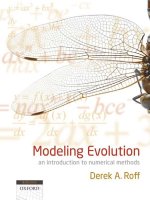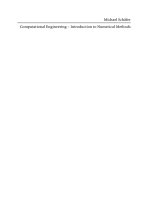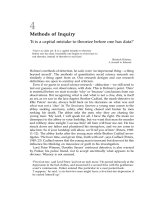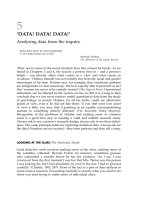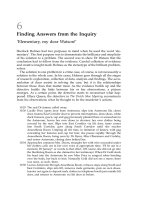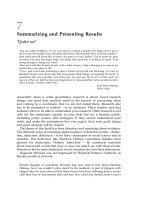Introduction to quantitative methods
Bạn đang xem bản rút gọn của tài liệu. Xem và tải ngay bản đầy đủ của tài liệu tại đây (2.5 MB, 314 trang )
Business Management
Study Manuals
Certificate in
Business Management
INTRODUCTION TO
QUANTITATIVE
METHODS
The Association of Business Executives
5th Floor, CI Tower St Georges Square High Street New Malden
Surrey KT3 4TE United Kingdom
Tel: + 44(0)20 8329 2930 Fax: + 44(0)20 8329 2945
E-mail: www.abeuk.com
©
Copyright, 2008
The Association of Business Executives (ABE) and RRC Business Training
All rights reserved
No part of this publication may be reproduced, stored in a retrieval system, or transmitted in
any form, or by any means, electronic, electrostatic, mechanical, photocopied or otherwise,
without the express permission in writing from The Association of Business Executives.
Certificate in Business Management
INTRODUCTION TO QUANTITATIVE METHODS
Contents
Unit
Title
Page
1
Basic Numerical Concepts
Introduction
Number Systems
Numbers – Approximation and Integers
Arithmetic
Dealing with Negative Numbers
Fractions
Decimals
Percentages
Ratios
Further Key Concepts
1
3
4
5
7
11
13
22
27
30
32
2
Algebra, Equations and Formulae
Introduction
Some Introductory Definitions
Algebraic Notation
Solving Equations
Formulae
39
40
40
43
50
54
3
Basic Business Applications
Introduction
Currency and Rates of Exchange
Discounts and Commission
Simple and Compound Interest
Depreciation
Pay and Taxation
61
62
62
66
68
74
77
4
Simultaneous, Quadratic, Exponential and Logarithmic Equations
Introduction
Simultaneous Equations
Formulating Problems as Simultaneous Equations
Quadratic Equations
Logarithmic and Exponential Functions
87
88
89
94
96
104
5
Introduction to Graphs
Introduction
Basic Principles of Graphs
Graphing the Functions of a Variable
Graphs of Equations
Gradients
Using Graphs in Business Problems
117
118
118
121
124
139
146
Unit
Title
Page
6
Introduction to Statistics and Data Analysis
Introduction
Data for Statistics
Methods of Collecting Data
Classification and Tabulation of Data
Frequency Distributions
171
172
173
175
177
185
7
Graphical Representation of Information
Introduction
Graphical Representation of Frequency Distributions
Pictograms
Pie Charts
Bar Charts
Scatter Diagrams
General Rules for Graphical Presentation
193
194
194
205
207
208
210
212
8
Measures of Location
Introduction
The Arithmetic Mean
The Mode
The Median
221
222
223
232
235
9
Measures of Dispersion
Introduction
Range
The Quartile Deviation, Deciles and Percentiles
Standard Deviation
The Coefficient of Variation
Skewness
249
250
251
252
255
262
263
10
Probability
Introduction
Estimating Probabilities
Types of Event
The Two Laws of Probability
Conditional Probability
Tree Diagrams
Sample Space
Expected Value
The Normal Distribution
275
276
277
279
280
286
288
294
295
298
1
Study Unit 1
Basic Numerical Concepts
Contents
Page
Introduction
3
A.
Number Systems
Denary Number System
Roman Number System
Binary System
4
4
4
4
B.
Numbers – Approximation and Integers
Approximation
Integers
5
5
6
C.
Arithmetic
7
Addition (symbol )
Subtraction (symbol )
Multiplication (symbol )
7
8
8
Division (symbol )
The Rule of Priority
Brackets
9
9
10
D.
Dealing with Negative Numbers
Addition and Subtraction
Multiplication and Division
11
11
13
E.
Fractions
Basic Rules for Fractions
Adding and Subtracting with Fractions
Multiplying and Dividing Fractions
13
15
18
20
F.
Decimals
Arithmetic with Decimals
Limiting the Number of Decimal Places
22
23
25
(Continued over)
©
ABE and RRC
2
Basic Numerical Concepts
G.
Percentages
Arithmetic with Percentages
Percentages and Fractions
Percentages and Decimals
Calculating Percentages
27
27
27
28
28
H.
Ratios
30
I.
Further Key Concepts
Indices
Expressing Numbers in Standard Form
Factorials
32
32
32
34
Answers to Questions
35
©
ABE and RRC
Basic Numerical Concepts
3
INTRODUCTION
The skill of being able to handle numbers well is very important in many jobs. You may often
be called upon to handle numbers and express yourself clearly in numerical form – and this
is part of effective communication, as well as being essential to understanding and solving
many business problems.
Sometimes we can express numerical information more clearly in pictures – for example, in
charts and diagrams. We shall consider this later in the course. Firstly though, we need to
examine the basic processes of manipulating numbers themselves. In this study unit, we
shall start by reviewing a number of basic numerical concepts and operations. It is likely that
you will be familiar with at least some of these, but it is essential to ensure that you fully
understand the basics before moving on to some of the more advanced applications in later
units.
Throughout the course, as this is a practical subject, there will be plenty of practice questions
for you to work through. To get the most out of the material, we recommend strongly that you
do attempt all these questions.
One initial word about calculators. It is perfectly acceptable to use calculators to perform
virtually all arithmetic operations – indeed, it is accepted practice in examinations. You should
therefore get to know how to use one quickly and accurately. However, you should also
ensure that you know exactly how to perform all the same operations manually.
Understanding how the principles work is essential if you are to use the calculator correctly.
Objectives
When you have completed this study unit you will be able to:
identify some different number systems
round-up numbers and correct them to significant figures
carry out calculations involving the processes of addition, subtraction, multiplication
and division
manipulate negative numbers
cancel fractions down to their simplest terms
change improper fractions to mixed numbers or integers, and vice versa
add, subtract, multiply and divide fractions and mixed numbers
carry out calculations using decimals
calculate ratios and percentages, carry out calculations using percentages and divide a
given quantity according to a ratio
explain the terms index, power, root, reciprocal and factorial.
©
ABE and RRC
4
Basic Numerical Concepts
A. NUMBER SYSTEMS
Denary Number System
We are going to begin by looking at the number system we use every day.
Because ten figures (i.e. symbols 0 to 9) are used, we call this number system the base ten
system or denary system. This is illustrated in the following table.
Seventh
column
Sixth
column
Fifth
column
Fourth
column
Third
column
Second
column
First
column
Millions
Hundreds
of
thousands
Tens of
thousands
Thousands
Hundreds
Tens
Units
Figure 1.1: The denary system
The number of columns indicates the actual amounts involved. Consider the number 289.
This means that, in this number, there are:
two hundreds (289)
eight tens (289)
nine units (289).
Before we look at other number systems, we can note that it is possible to have negative
numbers – numbers which are less than zero. Numbers which are more than zero are
positive. We indicate a negative number by a minus sign (). A common example of the use
of negative numbers is in the measurement of temperature – for example, 20°C (i.e. 20°C
below zero).
We could indicate a positive number by a plus sign (), but in practice this is not necessary
and we adopt the convention that, say, 73 means 73.
Roman Number System
We have seen that position is very important in the number system that we normally use.
This is equally true of the Roman numerical system, but this system uses letters instead of
figures. Although we invariably use the normal denary system for calculations, Roman
numerals are still in occasional use in, for example, the dates on film productions, tabulation,
house numbers, etc.
Here are some Roman numbers and their denary equivalent:
XIV
14
XXXVI
36
IX
9
LVlll
58
Binary System
As we have said, our numbering system is a base ten system. By contrast, computers use
base two, or the binary system. This uses just two symbols (figures), 0 and 1.
In this system, counting from 0 to 1 uses up all the symbols, so a new column has to be
started when counting to 2, and similarly the third column at 4.
©
ABE and RRC
Basic Numerical Concepts
Denary
5
Binary
0
0
1
1
2
10
3
11
4
100
5
101
6
110
7
111
8
1000
9
1001
Figure 1.2: The binary system
This system is necessary because computers can only easily recognise two figures – zero or
one, corresponding to "components" of the computer being either switched off or on. When a
number is transferred to the computer, it is translated into the binary system.
B. NUMBERS – APPROXIMATION AND INTEGERS
Approximation
Every figure used in a particular number has a meaning. However, on some occasions,
precision is not needed and may even hinder communication. For example, if you are
calculating the cost of the journey, you need only express the distance to the nearest mile.
It is important to understand the methods of approximation used in number language.
(a)
Rounding off
Suppose you are given the figure 27,836 and asked to quote it to the nearest thousand.
Clearly, the figure lies between 27,000 and 28,000. The halfway point between the two
is 27,500. The number 27,836 is more than this and so, to the nearest thousand, the
answer would be 28,000.
There are strict mathematical rules for deciding whether to round up or down to the
nearest figure:
Look at the digit after the one in the last required column. Then:
for figures of four or less, round down
for figures of five or more, round up.
Thus, when rounding off 236 to the nearest hundred, the digit after the one in the last
required column is 3 (the last required column being the hundreds column) and the
answer would be to round down to 200. When rounding off 3,455 to the nearest ten,
the last required column is the tens column and the digit after that is 5, so we would
round up to 3,460.
©
ABE and RRC
6
Basic Numerical Concepts
(However, you should note that different rules may apply in certain situations – for
example, in VAT calculations, the Customs and Excise rule is always to round down to
the nearest one pence.)
(b)
Significant figures
By significant figures we mean all figures other than zeros at the beginning or end of a
number. Thus:
632,000 has three significant figures as the zeros are not significant
000,632 also has only three significant figures
630,002 has six significant figures – the zeros here are significant as they occur
in the middle of the number.
We can round off a number to a specified number of significant figures. This is likely to
be done to aid the process of communication – i.e. to make the number language
easier to understand – and is particularly important when we consider decimals later in
the unit.
Consider the figure 2,017. This has four significant figures. To write it correct to three
significant figures, we need to drop the fourth figure – i.e. the 7. We do this by using the
rounding off rule – round down from 4 or round up from 5 – so 2,017 correct to three
significant figures becomes 2,020. To write 2,017 correct to one significant figure, we
consider the second significant figure, the zero, and apply the rule for rounding off,
giving 2,000. Do not forget to include the insignificant zeros, so that the digits keep
their correct place values.
Integers
Integers are simply whole numbers. Thus, 0, 1, 2, 3, 4, etc, are integers, as are all the
negative whole numbers.
The following are not integers:
¾, 1½, 7¼, 0.45, 1.8, 20.25
By adjusting any number to the nearest whole number, we obtain an integer. Thus, a number
which is not an integer can be approximated to become one by rounding off.
Questions for Practice 1
1.
2.
Round off the following the figures to the nearest thousand:
(a)
3,746
(b)
8,231
(c)
6,501
Round off the following figures to the nearest million:
(a)
6,570,820
(b)
8,480,290
(c)
5,236,000
©
ABE and RRC
Basic Numerical Concepts
3.
4.
7
Correct the following to three significant figures:
(a)
2,836
(b)
3,894
(c)
7,886
(d)
9,726
How many significant figures are in the following?
(a)
1,736
(b)
22,300
(c)
1,901
(d)
26,000
Now check your answers with those given at the end of the unit.
C. ARITHMETIC
We will now revise some basic arithmetic processes. These may well be familiar to you, and
although in practice it is likely you will perform many arithmetic operations using a calculator,
it is important that you know how to do the calculations manually and understand all the rules
that apply and the terminology used.
When carrying out arithmetic operations, remember that the position of each digit in a
number is important, so layout and neatness matter.
Addition (symbol )
When adding numbers, it is important to add each column correctly. If the numbers are
written underneath each other in the correct position, there is less chance of error.
So, to add 246, 5,322, 16, 3,100 and 43, the first task is to set the figures out in columns:
246
5,322
16
3,100
43
Total
8,727
The figures in the right hand column (the units column) are added first, then those in the next
column to the left and so on. Where the sum of the numbers in a column amount to a figure
greater than nine (for example, in the above calculation, the sum of the units column comes
to 17), only the last number is inserted into the total and the first number is carried forward to
be added into the next column. Here, it is 1 or, more precisely, one ten which is carried
forward into the "tens" column.
Where you have several columns of numbers to add (as may be the case with certain
statistical or financial information), the columns can be cross-checked to produce check
totals which verify the accuracy of the addition:
©
ABE and RRC
8
Basic Numerical Concepts
Columns
Totals
A
B
C
D
Totals
246
211
29
300
47
210
203
107
99
102
270
109
13
7
199
23
400
16
3
91
749
923
165
409
439
833
721
598
533
2,685
Rows
Note that each row is added up as well as each column, thus providing a full cross-check.
Subtraction (symbol )
Again, it is important to set out the figures underneath each other correctly in columns and to
work through the calculation, column by column, starting with the units column.
So, to subtract 21 from 36, the first task is to set the sum out:
36
21
Total
15
As with addition, you must work column by column, starting from the right – the units column.
Now consider this calculation:
34
18
Total
16
Where it is not possible to subtract one number from another (as in the units column where
you cannot take 8 from 4), the procedure is to "borrow" one from the next column to the left
and add it to the first number (the 4). The one that you borrow is, in fact, one ten – so adding
that to the first number makes 14, and subtracting 8 from that allows you to put 6 into the
total. Moving on to the next column, it is essential to put back the one borrowed and this is
added to the number to be subtracted. Thus, the second column now becomes 3 (1 1), or
3 2, which leaves 1.
Multiplication (symbol )
The multiplication of single numbers is relatively easy – for example, 2 4 8. When larger
numbers are involved, it is again very helpful to set out the calculation in columns:
246
23
©
ABE and RRC
Basic Numerical Concepts
9
In practice, it is likely that you would use a calculator for this type of "long multiplication", but
we shall briefly review the principles of doing it manually.
Before doing so though, we shall note the names given to the various elements involved in a
multiplication operation:
the multiplicand is the number to be multiplied – in this example, it is 246
the multiplier is the number by which the multiplicand is to be multiplied – here it is 23
and
the answer to a multiplication operation is called the product – so to find the product of
two or more numbers, you multiply them together.
Returning to our example of long multiplication, the first operation is to multiply the
multiplicand by the last number of the multiplier (the number of units, which is 3) and enter
the product as a subtotal – this shown here as 738. Then we multiply the multiplicand by the
next number of the multiplier (the number of tens, which is 2). However, here we have to
remember that we are multiplying by tens and so we need to add a zero into the units column
of this subtotal before entering the product for this operation (492). Thus, the actual product
of 246 20 is 4,920. Finally, the subtotals are added to give the product for the whole
operation:
246
23
Subtotal (units)
Subtotal (tens)
738
4,920
Total product
5,658
Division (symbol )
In division, the calculation may be set out in a number of ways:
360 24, or 360/24, or most commonly
360
24
Just as there were three names for the various elements involved in a multiplication
operation, so there are three names or terms used in division:
the dividend is the number to be divided – in this example, it is 360
the divisor is the number by which the dividend is to be divided – here it is 24 and
the answer to a division operation is called the quotient – here the quotient for our
example is 15.
Division involving a single number divisor is relatively easy – for example, 16 2 8. For
larger numbers, the task becomes more complicated and you should use a calculator for all
long division.
The Rule of Priority
Calculations are often more complicated than a simple list of numbers to be added and/or
subtracted. They may involve a number of different operations – for example:
863
©
ABE and RRC
8
2
10
Basic Numerical Concepts
When faced with such a calculation, the rule of priority in arithmetical operations requires
that:
division and multiplication are carried out before addition and subtraction.
Thus, in the above example, the procedure would be:
8
4
2
(a)
first the multiplication and division: 8 6 48;
(b)
then, putting the results of the first step into the calculation, we can do the addition and
subtraction: 48 3 4 49.
Brackets
Brackets are used extensively in arithmetic, and we shall meet them again when we explore
algebra.
Look at the previous calculation again. It is not really clear whether we should:
(a)
multiply the eight by six; or
(b)
multiply the eight by "six minus three" (i.e. by three); or even
(c)
multiply the eight by "six minus three plus four" (i.e. by seven).
We use brackets to separate particular elements in the calculation so that we know exactly
which operations to perform on which numbers. Thus, we could have written the above
calculation as follows:
(8 6) 3
8
2
This makes it perfectly clear what numbers are to be multiplied.
Consider another example:
12 3 3 6 1
Again there are a number of ways in which this calculation may be interpreted, for example:
(12 3) (3 6) 1
12 (3 3) (6 1)
(12 3) 3 (6 1)
(12 [3 3]) 6 1
Note that we can put brackets within brackets to further separate elements within the
calculation and clarify how it is to be performed.
The rule of priority explained above now needs to be slightly modified. It must be strictly
followed except when brackets are included. In that case, the contents of the brackets are
evaluated first. If there are brackets within brackets, then the innermost brackets are
evaluated first.
Example:
2 3 (6 8 2)
2 3 (6 4)
(within the brackets, the division first)
232
26
(multiplication before addition)
8
©
ABE and RRC
Basic Numerical Concepts
11
Thus we can see that brackets are important in signifying priority as well as showing how to
treat particular operations.
Questions for Practice 2
1.
2.
Work out the answers to the following, using a calculator if necessary.
(a)
937 61
(b)
1,460 159
(c)
59,976 63
(d)
19,944 36
Add each of the four columns in the following table and cross-check your answer.
A
B
C
D
322
219
169
210
418
16
368
191
42
600
191
100
23
46
328
169
Totals
Totals
3.
Work out the answers to the following questions.
(a)
(6 3) 6 4
(b)
(6 3) (6 4)
(c)
10 (5 2) (10 5)
(d)
24 24 (2 2)
(e)
6 (24 [4 2])
(f)
(15 [3 2] 6 [4 3] 2) 11
Now check your answers with those given at the end of the unit.
D. DEALING WITH NEGATIVE NUMBERS
Addition and Subtraction
We can use a number scale, like the markings on a ruler, as a simple picture of addition and
subtraction. Thus, you can visualise the addition of, say, three and four by finding the position
of three on the scale and counting off a further four divisions to the right, as follows:
0
1
2
3
4
5
6
This brings us to the expected answer of seven (3 4).
©
ABE and RRC
7
8
12
Basic Numerical Concepts
Similarly we can view subtraction as moving to the left on the scale. Thus, 6 minus 4 is
represented as follows:
0
1
2
3
4
5
6
7
8
This illustrates the sum 6 4 2.
Negative numbers can also be represented on the number scale. All we do is extend the
scale to the left of zero:
6
5
4
3
2
1
0
1
2
3
4
5
6
We can now visualise the addition and subtraction of negative numbers in the same way as
above. Consider the sum (3) 4. Start at 3 on the scale and count four divisions to the
right:
4
3
2
1
0
1
2
3
4
Therefore, (3) 4 1.
(Note that, here, we have shown the figure of "minus 3" in brackets to avoid confusion with
the addition and subtraction signs.)
The order of the figures of these calculations does not matter, so we can also write:
(3) 4 4 (3) 1
We can illustrate the second sum as follows:
3
2
1
0
1
2
3
4
5
This is the same as 4 3. In effect, therefore, a plus and a minus together make a minus.
With subtraction, the process is slightly different. To subtract a minus number, we change the
subtraction sign to a plus and treat the number as positive. For example:
4 (3) 4 3 7
To sum up:
a plus and minus make a minus
two minuses make a plus.
Consider the following examples. (Draw your own number scales to help visualise the sums
if you find it helpful.)
7 (3) 7 3 10
2 (6) 2 6 4
©
ABE and RRC
Basic Numerical Concepts
Multiplication and Division
The rules for multiplication and division are as follows:
Type of calculation
Minus times plus
Minus times minus
Minus divide by plus
Minus divide by minus
Plus divide by minus
Product/Quotient
minus
plus
minus
Example
3 7 21
7 (3) 21
21 3 7
plus
21 (3) 7
minus
21 (3) 7
Figure 1.3: Multiplying and dividing using negative numbers
Questions for Practice 3
Solve the following sums, using a number scale if necessary:
1.
7 (4)
2.
(4) 7
3.
8 (6)
4.
6 (8)
5.
(9) 3
6.
(8) (2)
7.
(5) (4)
8.
(3) (5)
9.
(7) (7)
10.
10 (10)
Now check your answers with the ones given at the end of the unit.
E. FRACTIONS
A fraction is a part of whole number.
When two or more whole numbers are multiplied together, the product is always another
whole number. In contrast, the division of one whole number by another does not always
result in a whole number. Consider the following two examples:
12 5 2, with a remainder of 2
10 3 3, with a remainder of 1
©
ABE and RRC
13
14
Basic Numerical Concepts
The remainder is not a whole number, but a part of a whole number – so, in each case, the
result of the division is a whole number and a fraction of a whole number. The fraction is
expressed as the remainder divided by the original divisor and the way in which it is shown,
then, is in the same form as a division term:
12 5 2, with a remainder of 2 parts of 5, or two divided by five, or
2
5
10 3 3, with a remainder of 1 part of 3, or one divided by three, or
1
3
Each part of the fraction has a specific terminology:
the top number is the numerator and
the bottom number is the denominator.
Thus, for the above fractions, the numerators are 2 and 1, and the denominators are 5 and 3.
When two numbers are divided, there are three possible outcomes.
(a)
The numerator is larger than the denominator
In this case, the fraction is known as an improper fraction. The result of dividing out an
improper fraction is a whole number plus a part of one whole, as in the two examples
above. Taking two more examples:
42
6
4 whole parts and a remainder of 6 parts of 9, or 4
9
9
30
6
1 whole part and a remainder of 6 parts of 24, or 1
24
24
(b)
The denominator is larger than the numerator
In this case, the fraction is known as a proper fraction. The result of dividing out a
proper fraction is only a part of one whole and therefore a proper fraction has a value of
less than one.
Examples of proper fractions are:
1 2 4 4
, , , , etc.
5 3 7 5
(c)
The numerator is the same as the denominator
In this case, the expression is not a true fraction. The result of dividing out is one whole
part and no remainder. The answer must be 1. For example:
5
551
5
Fractions are often thought of as being quite difficult. However, they are not really hard as
long as you learn the basic rules about how they can be manipulated. We shall start by
looking at these rules before going on to examine their application in performing arithmetic
operations on fractions.
©
ABE and RRC
Basic Numerical Concepts
15
Basic Rules for Fractions
Cancelling down
Both the numerator and the denominator in a fraction can be any number. The
following are all valid fractions:
2 20 47 6
,
,
,
5 50 93 9
The rule in expressing fractions, though, is always to reduce the fraction to the smallest
possible whole numbers for both its numerator and denominator. The resulting fraction
is then in its lowest possible terms.
The process of reducing a fraction to its lowest possible terms is called cancelling
down. To do this, we follow another simple rule. Divide both the numerator and
denominator by the largest whole number which will divide into them exactly.
Consider the following fraction from those listed previously:
20
50
Which whole number will divide into both 20 and 50? There are several: 2, 5, and 10.
However the rule states that we use the largest whole number, so we should use 10.
Dividing both parts of the fraction by 10 reduces it to:
2
5
Note that we have not changed the value of the fraction, just the way in which the parts
of the whole are expressed. Thus:
20
2
50
5
A fraction which has not been reduced to its lowest possible terms is called a vulgar
fraction.
Cancelling down can be a tricky process since it is not always clear what the largest
whole number to use might be. For example, consider the following fraction:
165
231
In fact, both terms can be divided by 33, but you are very unlikely to see that straight
away. However, you would probably quickly see that both are divisible by 3, so you
could start the process of cancelling down by dividing by three:
165 3
55
77
231 3
This gives us a new form of the same fraction, and we can now see that both terms can
be further divided – this time by 11:
55 11 5
77 11 7
So, large vulgar fractions can often be reduced in stages to their lowest possible terms.
©
ABE and RRC
16
Basic Numerical Concepts
Changing the denominator to required number
The previous process works in reverse. If we wanted to express a given fraction in a
different way, we can do that by multiplying both the numerator and denominator by the
same number. So, for example,
2
8
could be expressed as
by multiplying both terms by 4.
20
5
If we wanted to change the denominator to a specific number – for example, to express
½ in eighths – the rule is to divide the required denominator by the existing
denominator (8 2 4) and then multiply both terms of the original fraction by this
result:
1 4
4
24
8
Note again that we have not changed the value of the fraction, just the way in which the
parts of the whole are expressed.
Changing an improper fraction into a whole or mixed number
Suppose we are given the following improper fraction:
35
8
The rule for converting this is to divide the numerator by the denominator and place
any remainder over the denominator. Thus we find out how many whole parts there are
and how many parts of the whole (in this case, eighths) are left over:
35
3
35 8 4 and a remainder of three 4
8
8
This result is known as a mixed number – one comprising a whole number and a
fraction.
Changing a mixed number into an improper fraction
This is the exact reverse of the above operation. The rule is to multiply the whole
number by the denominator in the fraction, then add the numerator of the fraction to
this product and place the sum over the denominator.
For example, to write 3
2
as an improper fraction:
3
(a)
first multiply the whole number (3) by the denominator (3) 3 3 9, changing
the three whole ones into nine thirds
(b)
then add the numerator (2) to this 2 9 11, thus adding the two thirds to the
nine thirds from the first operation
(c)
finally place the sum over the denominator
11
3
©
ABE and RRC
Basic Numerical Concepts
Questions for Practice 4
1.
2.
3.
4.
Reduce the following fractions to their lowest possible terms:
(a)
9
36
(b)
8
64
(c)
21
70
(d)
18
54
(e)
14
49
(f)
25
150
(g)
36
81
(h)
45
135
(i)
24
192
(j)
33
88
Change the following fractions as indicated:
(a)
1
to 10ths
5
(b)
3
to 20ths
5
(c)
4
to 81sts
9
(d)
9
to 88ths
11
Change the following improper fractions to mixed numbers:
(a)
12
5
(b)
17
8
(c)
25
6
(d)
31
3
Change the following mixed numbers to improper fractions:
(a)
2
2
3
(b)
3
3
8
(c)
4
1
8
(d)
9
3
4
Now check your answers with those given at the end of the unit.
©
ABE and RRC
17
18
Basic Numerical Concepts
Adding and Subtracting with Fractions
(a)
Proper fractions
Adding or subtracting fractions depends upon them having the same denominator. It is
not possible to do these operations if the denominators are different.
Where the denominators are the same, adding or subtracting is just a simple case of
applying the operation to numerators. For example:
3
2
5
7
7
7
5
1
4
1
8
8
8
2
Where the denominators are not the same, we need to change the form of expression
so that they become the same. This process is called finding the common denominator.
Consider the following calculation:
2
3
10
5
We cannot add these two fractions together as they stand – we have to find the
common denominator. In this case, we can change the expression of the first fraction
by multiplying both the numerator and denominator by 2, thus making its denominator
10 – the same as the second fraction:
4
3
7
10
10
10
Not all sums are as simple as this. It is often the case that we have to change the form
of expression of all the fractions in a sum in order to give them all the same
denominator.
Consider the following calculation:
3
1
1
10
5
4
The lowest common denominator for these three fractions is 20. We must then convert
all three to the new denominator by applying the rule explained above for changing a
fraction to a required denominator:
3
1
1
12
5
2
15
3
10
20
20
20
20
5
4
4
The rule is simple:
find the lowest common denominator – and where this is not readily apparent, a
common denominator may be found by multiplying the denominators together
change all the fractions in the calculation to this common denominator
then add (or subtract) the numerators and place the result over the common
denominator.
©
ABE and RRC
Basic Numerical Concepts
(b)
19
Mixed numbers
When adding mixed numbers, we deal with the integers and the fractions separately.
The procedure is as follows:
first add all the integers together
then add the fractions together as explained above, and then
add together the sum of the integers and the fractions.
Consider the following calculation:
34
1
1
3
5 2
4
2
4
1 1 3
(3 4 5 2)
4 2 4
1 2 3
14
4 4 4
14
6
4
14 1
15
1
2
1
2
In general, the same principles are applied to subtracting mixed numbers. For example:
4
5
1
1 (4 1)
6
2
2
1
5 1
5 3
3
3 3
6
2
6
6
6
3
However, the procedure is slightly different where the second fraction is larger than the
first. Consider this calculation:
4
1
5
1
2
6
Here, it is not possible to subtract the fractions even after changing them to the
common denominator:
3
5
6
6
To complete the calculation we need to take one whole number from the integer in the
first mixed number, convert it to a fraction with the same common denominator and add
it to the fraction in the mixed number. Thus:
4
1
1
3 1 3
2
2
9
6 3
3
6
6 6
We can now carry out the subtraction as above:
4
©
1
5
9
5
4
2
9 5
1 3 1 (3 1) 2
2
2
6
6
6
6
3
6 6
ABE and RRC
20
Basic Numerical Concepts
Questions for Practice 5
Carry out the following calculations:
1.
1
1
3
4
2.
1
1
10
6
3.
1
2
8
3
4.
1
1
5
6
5.
2
3
5
4
6.
1
3
3
8
7.
3
1
4
8
8.
2
1
3
4
9.
5
1
6
3
10.
7
1
8
5
11.
5
1
7
3
12.
3
3
4
8
13.
2
14.
4
3
3
1
2 1
8
4
2
15.
2
1
1
31 2
3
2
5
16.
1
3
2
4
3
17.
4
5
1
2
9
3
18.
6
1
1
2
8
3
19.
2
1
1
1
2 2
8
3
6
20.
4
3
2
1
1 2
4
3
2
1
3
1
2
4
Now check your answers with those given at the end of the unit.
Multiplying and Dividing Fractions
(a)
Multiplying a fraction by a whole number
In this case, we simply multiply the numerator by the whole number and place the
product (which is now the new numerator) over the old denominator. For example:
2
25
10
1
5
3
3
3
3
3
3
37
21
1
7
5
4
4
4
4
We often see the word "of" in a calculation involving fractions – for example, ¼ of
£12,000. This is just another way of expressing multiplication.
©
ABE and RRC
Basic Numerical Concepts
(b)
21
Dividing a fraction by a whole number
In this case, we simply multiply the denominator by the whole number and place the old
numerator over the product (which is now the new denominator). For example:
3
3
3
5
20
4
45
2
2
2
5
3
35
15
(c)
Multiplying one fraction by another
In this case, we multiply the numerators by each other and the denominators by each
other, and then reduce the result to the lowest possible terms. For example:
3
2
32
6
1
12
4
3
43
2
3
3
33
9
40
8
5
85
(d)
Dividing by a fraction
In this case, we turn the divisor upside down and multiply. For example:
4
3
4
16
1
4
5
3
4
3
3
1
1
1
3
3
1
6
3
6
1
6
2
(e)
Dealing with mixed numbers
All that we have said so far in this section applies to the multiplication and division of
proper and improper fractions. Before we can apply the same methods to mixed
numbers, we must complete one further step – convert the mixed number to an
improper fraction. For example:
(f)
5
1
4
11
4
44
2
11
2
11
22
2
4
3
1
19
2
38
1
9
4
4
2
1
4
2
Cancelling during multiplication
We have seen how it is possible to reduce fractions to their lowest possible terms by
cancelling down. This involves dividing both the numerator and the denominator by the
same number, for example:
6
3
cancels down to
by dividing both terms by 2.
8
4
We often show the process of cancelling down during a calculation by crossing out the
cancelled terms and inserting the reduced terms as follows:
8 2
2
12 3
3
(It is always helpful to set out all the workings throughout a calculation. Some
calculations can be very long, involving many steps. If you make a mistake somewhere,
it is much easier to identify the error if all the workings are shown. It is also the case
©
ABE and RRC


